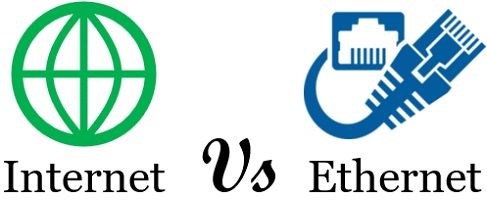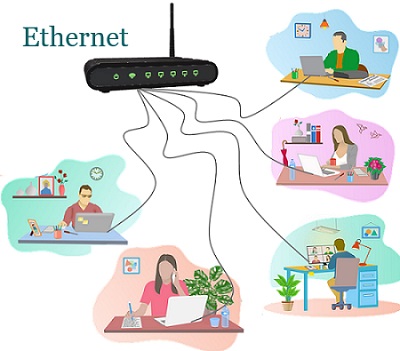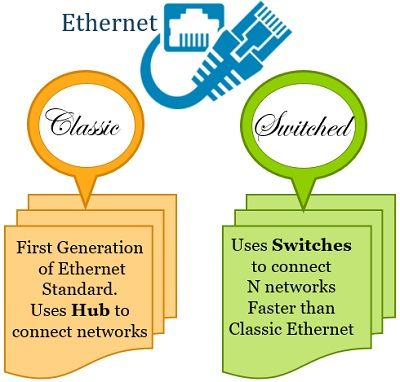 Internet and Ethernet both are the communication standards that enable connectivity between the communicating devices. Internet is a network of networks that gradually forms a wide area network (WAN). Meanwhile, Ethernet is a hardwired connection between the computers that gradually forms a local area network (LAN).
Internet and Ethernet both are the communication standards that enable connectivity between the communicating devices. Internet is a network of networks that gradually forms a wide area network (WAN). Meanwhile, Ethernet is a hardwired connection between the computers that gradually forms a local area network (LAN).
The Internet is a global network connecting users across the world. However, Ethernet is used to connect your device to the local area network. Although you can even use Ethernet to connect your device to the Internet also.
Let us explore more differences between the Internet and Ethernet.
Content: Internet Vs Ethernet
Comparison Chart
| Basis for Comparison | Internet | Ethernet |
|---|---|---|
| Basic | Network of networks, where connected computers uses TCP/IP protocols to communicate with each other. | Computers are connected in a geographically localized network using Ethernet cables. |
| Size | Global network, worldwide | Physically connects devices in a LAN |
| Security | Internet is less secure | Ethernet is comparatively more secure |
| Implementation | Internet uses point-to-point network | Uses broadcast network |
| Communication | It allows multiple communication taking place concurrently along its different paths | It allows only one communication at a time |
| Example | WAN | LAN |
What is Internet?
The Internet is a global network connecting millions of devices and facilitating worldwide communication. When you connect your device to the Internet, it means you are going online. It became a prominent resource for users across the world to exchange information.

The Internet enables you to send emails, videos, audio, photos, etc., to the other user on the network. Connecting your devices to the Internet will only let you access applications, websites, cloud data, social media apps, and many other similar services.
How does Internet work?
Explaining exactly how the Internet work is a difficult task. But let us try to understand a basic overview of its working.
We describe the internet as a global network of interconnected devices. Though we can use both wired and wireless mediums to develop a network, the physical cable forms the backbone of the Internet. The cables that we use to connect the devices can be telephone wires, TV cables, and fibre optic cables.
Now to search for a solution, you put a request in your browser’s search engine. The request is transmitted over these wires to the concerned server. The server is much like a hard drive where the website stores its data.
When the server receives the request, it processes the request to understand the need of the user. It then retrieves the requested data and sends it back to the requesting source.
Types of Internet
The different types of Internet connections are:
- Dial-Up
The user links their computer to a phone line in a dial-up connection. Here, the user has to dial a phone number to connect to the Internet hence we refer to it as a Dial-UP connection. This type of connection does not allow users to make or receive a phone call while using the Internet. However, it is an outdated type of Internet connection. - Broadband
The broadband connection is much faster than compared to a dial-up connection. In this, the user connects their computer to the Internet via phone line or cable. The speed of the Internet depends on the type of cable used. - DSL (Digital Subscriber Line)
In a DSL connection, the users connect their computers to the Internet via a telephone line. Unlike dial-up, the user here does not have to dial a phone number to connect to the Internet. DSL promises high-speed digital communication. It is actually a set of technologies such as – ADSL, VDSL, HDSL, and SDSL. - Cable
To access the Internet, the user has to connect their computer to a TV cable. Though it provides high-speed Internet, there are different uploading and downloading speeds. - Satellite Connection
It is not possible to access the Internet via telephone line or cable in every geographical region. In such areas, satellite connection provides an easy solution to access the Internet. Here, the signals travel a long distance, i.e. from earth to satellite and from the satellite back again to earth. So, it offers a delayed connection. - Wireless Connection
As the connection is wireless, we do not require any cable or phone line to connect the device to the Internet. This connection makes use of radio frequencies to operate.
Use of Internet
Although the main reason behind evolving of the Internet was communication between computers across a long or short distances. However, today every individual is dependent on the Internet to resolve their basic requirements. The list is long but let us discuss some common uses, such as:
- Sending emails
- Sharing messages, photos, videos and audio
- Booking tickets online
- Online shopping
- To access social networking sites and apps
- Online courses
- Entertainment
- For cashless transactions
What is Ethernet?
Ethernet is a technology used to establish a LAN network using wired channels. It connects devices within LAN and also WAN. Ethernet enables the computers connected in LAN to communicate with each other with the help of some protocols.

Here, the devices are connected in a geographically localized network using Ethernet cables. Ethernet offers fast connectivity and high-speed connection to the Internet.
We can classify Ethernet into two types:
- Classic Ethernet
It is an early version of Ethernet where the data rate ranges from 3 to 10 Mbps. - Switched Ethernet
Switched Ethernet is what Ethernet has become today. Here the data rate ranges from 100, 1000, and 10,000 Mbps. The networking device that we used to establish the network is a switch.
How does Ethernet Work?
We know Ethernet is a technology that we can use to establish a connection between the computers to form a LAN. Ordinarily, when one computer in the network wants to send information to another computer, it has to go through a certain process. The information is segmented into packets.
In addition to the data, the packet carries some standard information also. This standard information is the source and destination address. As a matter of fact, this information helps the network to identify the packet’s route. Undeniably all computers in ethernet share a single connection.
Thereby, the Ethernet follows the principles of CSMA/CD. These protocols make sure that the connection line is free before it starts sending the packets out. However, this is not the scenario nowadays. As Ethernet now operates on full-duplex mode. In full-duplex, the sending and receiving channels are explicitly separate.
Particularly, Ethernet does not perform any error correction. Thus, it has to rely on advanced protocols to ensure that data is transmitted perfectly. Consequently, Ethernet forms the basis for most of the network’s connections today.
Types of Ethernet
Ethernet is a technology connecting computers in a wired network. Now, these wires/cables can be classified into three types as below:

- Standard Ethernet – It offers a data rate of 1 to 10 Mbps
- Fast Ethernet – It offers a data rate of 100 Mbps
- Gigabit Ethernet – It offers a data rate of 1 Gbps
- 10-Gigabit Ethernet – It offers a data rate of 10 Gbps
Use of Ethernet
Some of the uses of Ethernet are as below:
- Connecting devices in a LAN network.
- It enables the devices to access the Internet.
- As it uses a wired medium to connect, it ensures a reliable, fast and secure connection.
Key Differences Between Internet and Ethernet
- The Internet is a global network where connected computers use TCP/IP protocol to communicate with each other. However, in Ethernet, the commuters are connected with each other using Ethernet cable to form a local area network.
- If we compare the Internet and Ethernet based on size, then the Internet is bigger than Ethernet. The Internet is a worldwide network that connects computers across the world. Whereas Ethernet connects computers in a LAN using the hard-wired medium.
- Internet is comparatively less secure as anyone can gain access to the network to retrieve information. On the other hand, Ethernet is more secure because no outer devices can access the local network.
- The Internet uses the point-to-point network to implement communications between the computers connected to the Internet. Ethernet uses broadcast networks to implement communication.
- The Internet allows multiple communication at the same time, as here, the communication takes place concurrently along the different paths of the network. However, the Ethernet allow only one communication at a time.
- WAN is an example of the Internet that connects computers worldwide. While computers connected to LAN using Ethernet cables are an example of Ethernet.
Conclusions
Internet and Ethernet are communication technology that connects commuter so that they can communicate with each other. Internet connects computers all over the world, whereas Ethernet is a technique that connects computers in LAN using Ethernet cable.

Leave a Reply